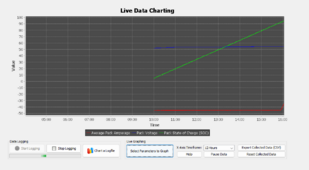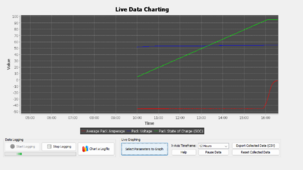No that's not the float. If you charge the your float voltage your battery may not get full in the span of one day. I prefer not to throw away solar production so I like to charge to full.That's basically what I'm getting at, yeah. When the CV absorption current tapers all the way down to near zero it's a matter of terminology if you want to call that the float or just the tailed off end of an absorption phase. I'm still calling it the float. And it does end after a few hours anyway, like you say if this was a 24/7 charging standby power application the considerations would be different.
You are using an out of date browser. It may not display this or other websites correctly.
You should upgrade or use an alternative browser.
You should upgrade or use an alternative browser.
Why is bulk/absorption voltage used?
- Thread starter hwy17
- Start date
hwy17
Anti-Solar Enthusiast
If my absorb is 55v and my float is 55v then it is my float. The float is just the near zero tail of the absorb.No that's not the float.
Or your absorb. If they are set to theme voltage then you don't have a float because by definition float voltage is different than absorb.If my absorb is 55v and my float is 55v then it is my float. The float is just the near zero tail of the absorb.
In other words of you have your absorb and float at the same voltage all you are doing is charging the battery to your "full" voltage and keeping it there
hwy17
Anti-Solar Enthusiast
you don't have a float because by definition float voltage is different than absorb.
Float voltage - Wikipedia
This is just splitting terminology hairs so I don't really care if you want to call it something else, but I understand float voltage to simply be defined as the voltage the battery is held at after it is fully charged regardless of whether it's independently phased or differentiated from absorb voltage.Float voltage is the voltage at which a battery is maintained after being fully charged to maintain that capacity by compensating for self-discharge of the battery. The voltage could be held constant for the entire duration of the cell's operation (such as in an automotive battery) or could be held for a particular phase of charging by the charger.
So you agree that you first have to fully charge the batteryFloat voltage - Wikipedia
en.wikipedia.org
This is just splitting terminology hairs so I don't really care if you want to call it something else, but I understand float voltage to simply be defined as the voltage the battery is held at after it is fully charged regardless of whether it's independently phased or differentiated from absorb voltage.
hwy17
Anti-Solar Enthusiast
I believe that a battery that has absorbed all the way down to 0ish amps at 55v is fully charged, for practical intents and purposes.So you agree that you first have to fully charge the battery
The reason for a float voltage is to prevent a cell getting fully charged (= lithium plating), when the system is held at that voltage in summer.
EV charging doesn’t have that issue, they charge to a setpoint then turn off.
If you have picked a single voltage that results in a cell being fully charged you will end up damaging that cell.
EV charging doesn’t have that issue, they charge to a setpoint then turn off.
If you have picked a single voltage that results in a cell being fully charged you will end up damaging that cell.
hwy17
Anti-Solar Enthusiast
How about 3.4375, damaging to hold for 3-8 hours per day?The reason for a float voltage is to prevent a cell getting fully charged (= lithium plating), when the system is held at that voltage in summer.
EV charging doesn’t have that issue, they charge to a setpoint then turn off.
If you have picked a single voltage that results in a cell being fully charged you will end up damaging that cell.
EV chargers do turn off, but they hold and top up at their setpoint until balancing is done. Which might take a couple hours.
Last edited:
Partimewages
Solar Addict
I think below 3.4.
It’s damaging the instant you are holding that voltage and there is no room left for intercalation.How about 3.4375, damaging to hold for 3-8 hours per day?
EV chargers do turn off, but they hold and top up at their setpoint until balancing is done. Which might take a couple hours.
hwy17
Anti-Solar Enthusiast
What's that, about 95% soc?
hwy17
Anti-Solar Enthusiast
Yeah but don't take my SOC graph for hard data here, I am still learning Orion's SOC config and I don't know if it has drifts happening in this chart. But if I multiply the amps volts and time I do believe there is nearly 95% of the rated capacity (972x16wh) in that bulk phase, maybe 90%.What's that, about 95% soc?
The amps and volts are hard data though.
Last edited:
sunshine_eggo
Happy Breffast!
With low C rate charges like that, only slow charging happens. 
45A/304Ah = 0.15C
45A/304Ah = 0.15C
hwy17
Anti-Solar Enthusiast
I see the possibility that if you have .3C peak at mid day, it's possible 55v it's gonna limit your input a bit.With low C rate charges like that, only slow charging happens.
45A/304Ah = 0.15C
At the same time, I hear it commonly stated that people are not designing their system to operate much over .1C.
Last edited:
hwy17
Anti-Solar Enthusiast
hwy17
Anti-Solar Enthusiast
@sunshine_eggo so let's say my application won't exceed .15C. And it looks like charging speed at .15C is not limited by the limited over potential of a single voltage charging scheme.
So, then if the two considerations remaining are wanting to achieve balancing voltage and not wanting to hold too high of a voltage, do you have an idea where you'd land in the 3.4-3.45 range? I've been looking at 3.437, but I'm wondering if 3.425 is more like it. Maybe even lower.
So, then if the two considerations remaining are wanting to achieve balancing voltage and not wanting to hold too high of a voltage, do you have an idea where you'd land in the 3.4-3.45 range? I've been looking at 3.437, but I'm wondering if 3.425 is more like it. Maybe even lower.
sunshine_eggo
Happy Breffast!
I like to keep it simple.
I have two modes:
1) don't care so much about charge time, but want to keep it reasonable and minimize cell stress: 3.45V/cell
2) Want to charge on generator, get close to full and terminate with near zero absorption, 3.55-3.65V/cell
I have two modes:
1) don't care so much about charge time, but want to keep it reasonable and minimize cell stress: 3.45V/cell
2) Want to charge on generator, get close to full and terminate with near zero absorption, 3.55-3.65V/cell
FWIW, I just charge until 3.45V is reached for the max cell, but reduce the charge current (in about 4 stages) once the SOC exceeds 90%. This gives the balancer time to do its job, which triggers above 3.4V/cell). The charge profile is further modified depending on temperature. I used this image from EVE as a guidance for the lower charge rates... I can only do 0.35C max anyway with 100A charge into 280Ah cells.

hwy17
Anti-Solar Enthusiast
Just to confirm what might be supposed to be obvious, is this because you are balancing in your (modified) absorption and will go into a lower float where you can't balance? Or is it about giving time to balance within the constraints of the solar day?This gives the balancer time to do its job
Similar threads
- Replies
- 9
- Views
- 287
- Replies
- 12
- Views
- 333
- Replies
- 57
- Views
- 2K
- Replies
- 1
- Views
- 128




